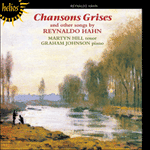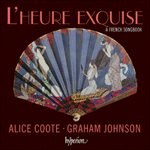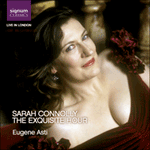
Welcome to Hyperion Records, an independent British classical label devoted to presenting high-quality recordings of music of all styles and from all periods from the twelfth century to the twenty-first.
Hyperion offers both CDs, and downloads in a number of formats. The site is also available in several languages.
Please use the dropdown buttons to set your preferred options, or use the checkbox to accept the defaults.

The composer had the idea of juxtaposing Banville’s latter-day rondels with three of Charles d’Orléans originals (the second, sixth and eighth songs of the cycle). At the end there is a rondel by Catulle Mendès which, with its reference to singing, may well have been written as a closing item for this cycle at Reynaldo’s request. Hahn’s lavish musical plan included the use of a chorus in the first, sixth and eleventh items; this makes modern-day performance of the work on the concert platform expensive and unlikely. The musical style of the Banville settings is more or less in the ‘modern’ style of the composer’s second Recueil of mélodies (some of the piano parts are as difficult as anything he wrote for the instrument) while in contrast the Charles d’Orléans settings bring out Hahn’s gifts as a pasticheur. There had been a long tradition in the composers of mélodie (Gounod and Fauré were the greatest, but by no means the only examples) of matching early poetry with music in ‘madrigal’ style evocative of earlier times. The use of this time-travelling in film music has rather debased the coin (despite Walton’s splendid music for Olivier’s Henry V) and after hearing ‘early’ music churned out by the yard in costume dramas, listeners no longer regard pastiche as serious composition. It was, however, something on which Reynaldo was increasingly to rely for the visitations of his muse. In any case, at the turn of the century even a giant like Debussy (in his Villon ballads and his own settings of Charles d’Orléans) was not above the use of archaic colour in his songs to suggest the fifteenth-century provenance of the words. Ravel too had an early success with his Pavane pour une infante défunte.
from notes by Graham Johnson © 1996
 Hahn: Chansons grises & other songs Hahn: Chansons grises & other songs‘Beautifully performed’ (Gramophone) ‘Martyn Hill’s tenor is perfectly suited to Hahn’s deliciously sentimental idiom … most of the settings on the disc are to texts by his favourite ...» More |
 L'heure exquise L'heure exquiseA French Songbook of distinction from the exquisite Alice Coote and Graham Johnson.» More |
 The exquisite hour The exquisite hourAccompanied by Eugene Asti, Sarah Connolly sings songs by Haydn, Brahms, Hahn, Korngold and Weill. Her distinctive, intelligent, warm, bright-sounding mezzo-soprano will be enjoyed by her growing 'army' of fans in this rich, romantic repertoire.» More |

